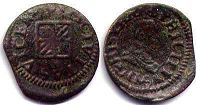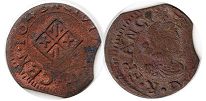Vic coins catalog with values
In the first century AD, the Romans defeated the Iberian Auzetes and destroyed
their capital Ausa. One of the hills near the Meder River was chosen for the
foundation of a new city, on the highest point of which a temple was built.
During the period of Visigothic domination, Auso was the center of the
episcopate. The city was supposedly destroyed by the Moors in the early 7th
century.
In the 9th century, the Carolingian conquest led to a new settlement on the
plain of Vic. After the creation of the county of Ausso (around 878), the
ancient Roman town of Ausso was rebuilt. A castle was built on the site of the
temple. The new town was named Vikus Ausonensis (i.e. suburb of Ausona, a name
that apparently transformed into Vic). The episcopal cathedra was re-established
and a new cathedral was built.
In the Middle Ages Vic was divided into two parts - episcopal (passed into the
hands of the king in 1316) and feudal (owners of the castle of the Moncada
family). The town grew considerably and was surrounded by a fortress wall,
renewed in the 14th century. In 1450 the part of Vic belonging to the
descendants of the Moncada family was sold to King Alfonso the Magnanimous.
In the late Middle Ages, due to the struggle of local feudal lords and wars with
France, the city lost its former importance. During the war years, Vic supported
Archduke Charles, and the defeat of the pretender in 1714 further contributed to
his humiliation.
The economic boom of the 18th century led to a new growth of the town. In the
19th century Vic suffered from wars and economic crisis, but the construction of
a railroad between Vic and Barcelona in 1875 helped its revival.
City of Vic
dinero
Philipp III king of Spain (1598-1621)

dinero no date (1611)
copper
VICERSIS CIVITAS
PHILIPPVS D G HISPAN R
Value - 15-20 USD
Luis XIII king of France (1641-1643)

dinero 1643
copper
CIVITASVICEN 1643
LVDO D G FRANC
Value - 20-30 USD
Coins of Vic in the catalog are presented divided by historical periods, indicating the main characteristics and differences by type.
Inside the sections, the coins are sorted by denomination - from large to small.
The cost of the coin is approximate and is indicated specifically for the coin shown in the picture. You can use this price to evaluate similar coins (of the same type), but remember that the value is affected by many factors, such as the state of preservation and the date of minting. The cost of coins of the same type can vary greatly depending on the number of surviving copies.
Coins of Vic presented on this page are not sold or bought - this is only a catalog.
